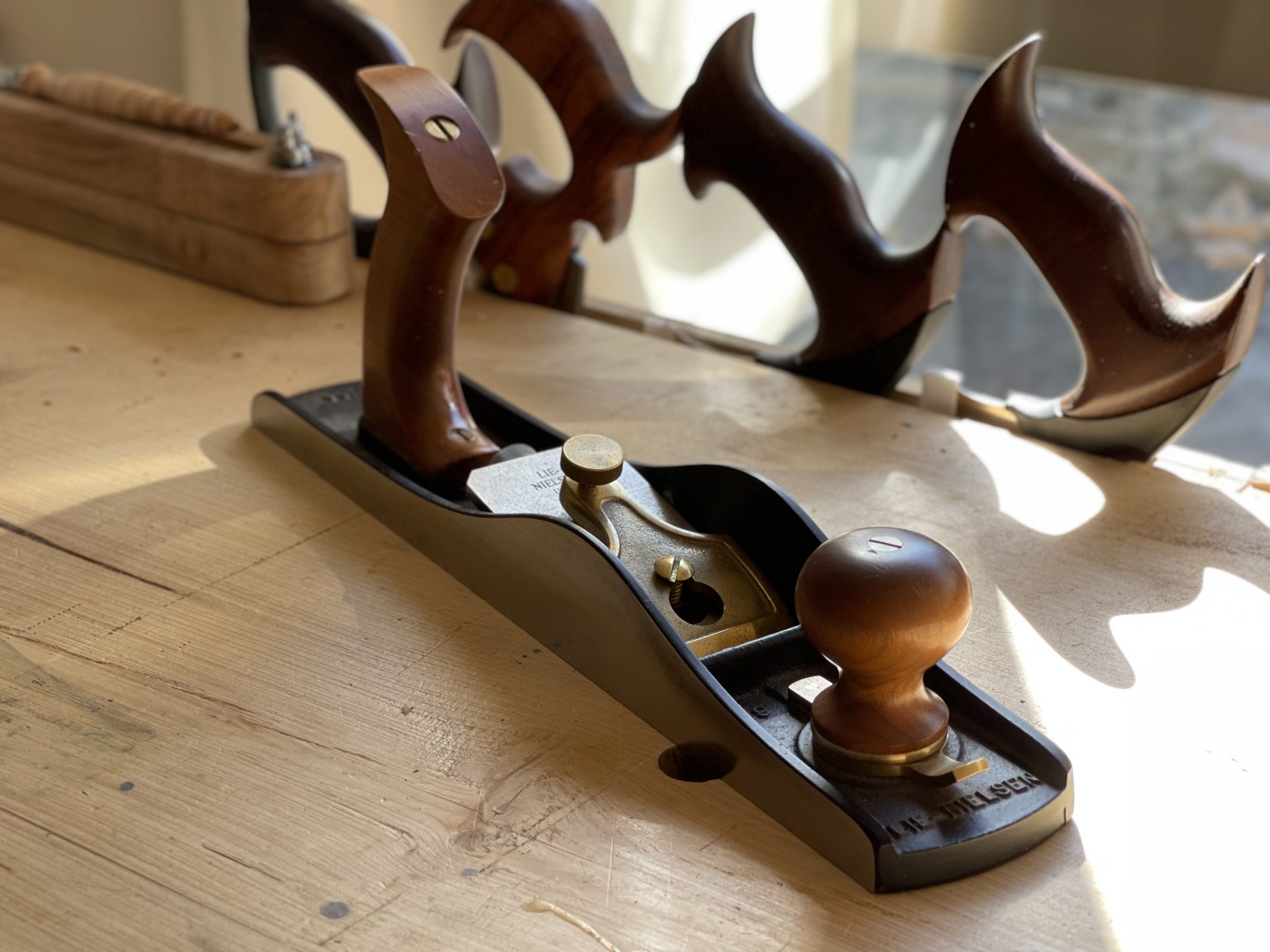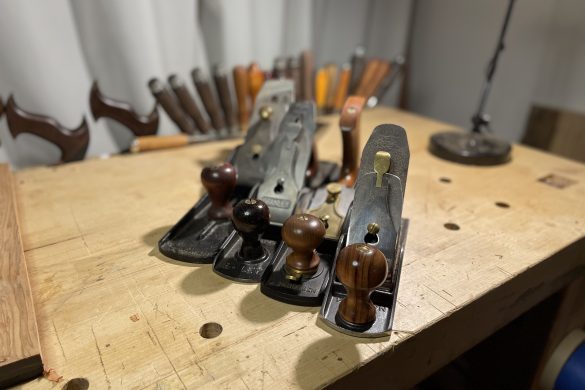Proclamation
Purchasing a tool for woodworking is complicated business. One never simply purchases just a tool. A hammer begets nails. A drill begets bits and screws. Chisels beget a sharpening system. A bench plane begets more bench planes. Our inner cheapskate often leads us to the aisle/website where our category of tool resides, scanning the shelf/page for the cheapest one and putting that item inside of our shopping cart/shopping cart. This works well for the DIYers who complete a single furniture project for the home and then sell everything on their local resale site. For those who are investing in a business, side hustle, or simply a lifelong hobby, constantly going cheap can be detrimental to progress.
Beat to death is the topic of beginner bench planes in the realm of woodworking – specifically which types to buy first. This debate has gone on for decades, maybe centuries, and it will probably never end. Here I put forward my opinion on the topic of a first bench plane and while I make suggestions as to the first to begin your arsenal, I am offering a further suggestion. It is not a unique opinion but it is one that I hold and after getting over the hump of purchasing my first bench plane, I am glad I made the decision that I made.
Assertions
My first assertion is that your first bench plane should be some form of jack or fore plane. A No. 5, No. 5½, or a No. 6 all fit the bill. If you want a plane that is a little more diverse in operation, a No. 62, or low-angle jack plane, will also do. A jack plane, its namesake bestowed as it is the jack-of-all-trades bench plane, ranges from around 14 inches to 16 inches long. The longer fore plane can be anywhere from 16 to 20.
Any bench plane task you want to do can be done with this single plane – from rough stock removal to glass-sheen smoothing. With a few modifications to the plane and blade for each different operation, a jack plane can perform like a scrub, a jointer, or a smoother. I will not get into the details of how to accomplish these tasks with a single plane as that is outside the scope of this particular entry but with a little know-how and a little effort, trust me, all of these things can be accomplished. Perhaps in a future post I can clarify and even provide examples.
The available options for bench planes in the 21st century are surprisingly numerous. The issue though is that the range of quality goes from superb to down right trash (looking at you AmazonBasics). As a beginner, it was hard for me to sift through quality selections versus near-future landfill occupants. This leads me to my second assertion. You should purchase a brand new bench plane from a reputable manufacturer and it should be uncomfortably expensive. Alternatively, you should purchase a plane from a reputable tool restorer and, you guessed it, pay an uncomfortable amount of money for it. We will call these types of bench planes the “premium” bench planes.
When I speak of reputable manufactures or professionally restored planes, here are some recommendations. I will also list the price range you can expect to pay for the recommended plane. They are expensive. They are worth it. I will cover reasons soon after the list.
| Manufacturer | Model | Price Range (USD) |
|---|---|---|
| Veritas | Low-Angle Jack | $250-$270 |
| Veritas | #5 Jack | $340-$350 |
| Veritas | #5½ Jack | $350-$360 |
| Veritas | #6 Fore | $270-$290 |
| Lie Nielsen | No. 62 Low-Angle Jack | $265 |
| Lie Nielsen | No. 5 Jack | $350-$360 |
| Lie Nielsen | No. 5½ Jack | $375-$385 |
| Lie Nielsen | No. 6 Fore | $375-$385 |
| Clifton | No. 5 Jack | $400-$430 |
| Clifton | No. 5½ | $420-$450 |
| Stanley | Any professionally restored version of the planes above from the 1910s to the 1940s. | Price drastically varies but $150-$400 depending on how much work was done. |
I consider these reputable manufacturers of premium planes. There may be more out there. Before you take my word for these specific planes, do a little more research, ask around, gather more information, and then make a choice.
My first bench plane was the No. 62 by Lie Nielsen. The pros and cons of the low-angle jack are well established on other woodworking sites so there is little need to discuss them here. However, when searching for my first western-style hand plane, I did my research. I poured through reviews, videos, and forums to determine what to get. Do the same with your first bench plane.
Full Disclosure - My First Bench Plane
Reasons
One thing you may notice is that I do not recommend a vintage, restorable plane purchased from a reseller. While plane restoration is a fun task, it is also not easy or intuitive. I also don’t recommend a new plane from a company with questionable quality in order to attempt tuning it to something usable. I’d like to establish some reasons why I recommend choosing one of the premiums as a first bench plane.
It Sets the Standard
If a new woodworker has never used a properly tuned hand plane, how do they suppose to know how it should feel and work? This means attempting to restore one straight from the yard sale line may be a little daunting. There are too many variables that could be out of place (missing parts, broken castings) that a beginner may not know to look for. I recommend eventually taking on this task, but make that a project for your second or third plane.
In the same reasoning as the restoration, a new plane of questionable quality does not set a good standard. How would a beginner know where to start troubleshooting issues like chatter, major tear-out, chip-breaker issues, etc. if they have never known what the plane is supposed to feel like?
The argument could be given that even a premium plane could suffer from these issues. Yes, that is true. The issue in these instances is often from a plane that is not properly set-up rather than an issue with the manufacturing of the plane itself. Issues with set up can be corrected by spinning some knobs or loosening/tightening some screws. Issues with manufacturing requires extra tools and knowledge the beginner may not have.
Out-of-the-Box Ready
Upon purchase, one of these is “ready-to-go” straight out of the box. You open the box, maybe touch up the blade on a stone or strop, and then you get to work. There is no checking the sole for flat, ensuring chip breaker alignment across the blade, no fiddling with the configuration of the frog, and no worry that when you push through your first shaving that the tote may split in half in your hand.
Some may see this as a lazy excuse and a cop-out for not wanting to understand how your tool works. It is quite the opposite. Refer to the first reason. Get a nice plane that is ready to be used out of the box so you can begin to understand what to expect in future purchases.
Inclination for Care
These hand planes are cast iron. They will rust. The blade will dull. They will get dust and crud on them. When someone spends a good sum of money on a piece of equipment, they are more inclined to take proper care of it. This includes regular oiling, regular sharpening, and regular cleaning. With a premium plane that you are more inclined to take care of in the beginning, you will develop good tool maintenance habits first.
Generationally Future-Proof
This is about to take a turn for the serious. You may be a father. Or a mother. Or a cool uncle, aunt, grandparent, or god-parent. You have family. A younger family member may look up to you. They may visit your workshop on occasion as you dive deeper into the craft. They may eventually take up your mantle and begin woodworking themselves.
Having these relationships, forming these bonds, and instilling the rich history of woodworking is a by-product of good craftsmanship. You will die eventually. It is a fact of life. When you go, or when you get too old to push a hand plane anymore, your tools need to go somewhere. Perhaps to that young family member? You should leave them something of quality.
Fin
Your first bench plane should be a jack plane or a fore plane. They are a diverse plane capable of any task at the bench. This is precisely what you need in your first couple of projects. This is the bench plane where you need to learn proper technique and begin forming good habits. Others recommend starting with three planes – a smoother, a jack, and the long jointer. I disagree.
While others have espoused the idea that your jack plane should be set up in a specific configuration to accomplish a single goal at the bench, that is incorrect. Your jack plane should be set up to accomplish the goal that you need it to accomplish unless you have another bench plane that accomplishes that goal. And the first jack plane you do it with should be a premium one, purchased by a reputable manufacturer or restorer, at painful cost, and you should take care of it as such. When the time comes, and it will, it should be passed on to someone who will take as good or better care of it than you did.

